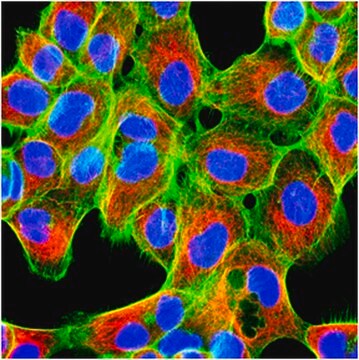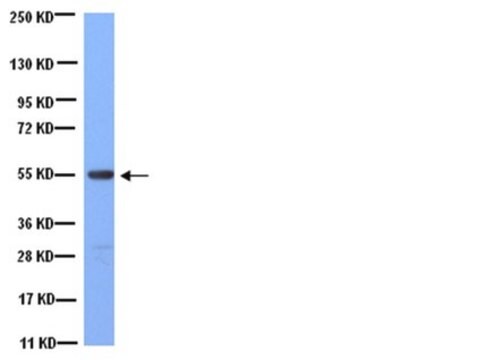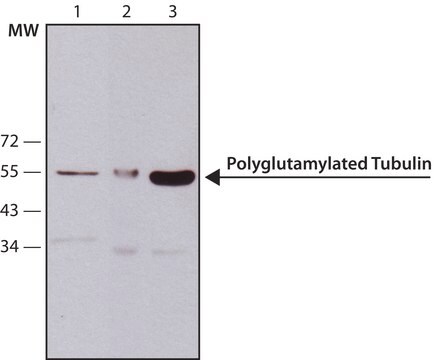推荐产品
生物源
mouse
品質等級
抗體表格
purified from hybridoma cell culture
抗體產品種類
primary antibodies
無性繁殖
TUB-1A2, monoclonal
形狀
buffered aqueous solution
分子量
~55 kDa
物種活性
Xenopus, Arabidopsis sp., yeast, insect, rat, hamster, porcine, monkey, bovine, human, mouse, canine, chicken
濃度
~1 mg/mL
技術
immunoblotting: suitable
immunofluorescence: 2-4 μg/mL using human HeLa or Chicken fibroblast cells
immunohistochemistry: suitable
同型
IgG3
UniProt登錄號
運輸包裝
dry ice
儲存溫度
−20°C
目標翻譯後修改
unmodified
基因資訊
human ... TUBA1A(7846)
一般說明
Anti-Tubulin, Tyrosine antibody, Mouse monoclonal (mouse IgG3 isotype) is derived from the TUB-1A2 hybridoma, produced by the fusion of mouse myeloma cells and splenocytes from mouse. Tubulin is an intracellular cylindrical filamentous structure and is presented in eukaryotic cells. It consists of three isoforms α-, β- and γ-tubulin. Tubulin is a heterodimer of α- and β- tubulin subunits.
特異性
Anti-Tubulin, Tyrosine antibody, Mouse monoclonal specifically recognizes the C-terminal Tyrosine of Tubulin protein. The antibody is non-reactive with cells that have been treated with pancreatic carboxypeptidase A under conditions which remove only the C-terminal tyrosine. Monoclonal Anti-Tubulin, Tyrosine recognizes Tubulin from human, mouse, chicken, bovine, rat, hamster, canine, monkey, porcine, arabidopsis, tobacco, yeast, Xenopus, insect, comb jelly, sponge, and worm origin.
免疫原
a synthetic peptide containing the carboxy terminal amino acids of porcine a-tubulin
應用
Anti-Tubulin, Tyrosine antibody, mouse monoclonal may be used in:
- immunoblotting
- immunofluorescence
- immunohistochemistry
生化/生理作用
Tubulin is the major building block of microtubules which is essential for structural and mobility elements in mitosis, intracellular transport, flagellar movement and in the cytoskeleton. It is also involved in the nervous system. Tubulin is associated with neurodegenerative disorders such as Alzheimer′s and Parkinson′s disease. Mutations in the αβ- dimers and γ-tubulin are associated with malformation and impairment of cognitive disorders.
外觀
Solution in 0.01 M phosphate buffered saline, pH 7.4, containing 15 mM sodium azide.
儲存和穩定性
For continuous use, store at 2–8 °C for up to one month. For extended storage, freeze in working aliquots. Repeated freezing and thawing is not recommended. If slight turbidity occurs upon prolonged storage, clarify the solution by centrifugation before use. Working dilution samples should be discarded if not used within 12 hours.
免責聲明
Unless otherwise stated in our catalog, our products are intended for research use only and are not to be used for any other purpose, which includes but is not limited to, unauthorized commercial uses, in vitro diagnostic uses, ex vivo or in vivo therapeutic uses or any type of consumption or application to humans or animals.
未找到合适的产品?
试试我们的产品选型工具.
儲存類別代碼
12 - Non Combustible Liquids
水污染物質分類(WGK)
WGK 1
閃點(°F)
Not applicable
閃點(°C)
Not applicable
D Boucher et al.
Biochemistry, 33(41), 12471-12477 (1994-10-18)
The multiple functions of microtubules are mediated by various structural and motor microtubule-associated proteins (MAPs). To harmonize these functions in different places of a single cell, the key problem is to regulate the interactions of these proteins with microtubules. The
Soumyananda Chakraborti et al.
Cytoskeleton (Hoboken, N.J.), 73(10), 521-550 (2016-10-19)
Across different cell types and tissues, microtubules are assembled from highly conserved dimers of α- and β-tubulin. Despite their highly similar structures, microtubules have functional heterogeneity, generated either by the expression of different tubulin genes, encoding distinct isotypes, or by
Jennetta W Hammond et al.
Current opinion in cell biology, 20(1), 71-76 (2008-01-30)
All microtubules are built from a basic alpha/beta-tubulin building block, yet subpopulations of microtubules can be differentially marked by a number of post-translational modifications. These modifications, conserved throughout evolution, are thought to act individually or in combination to control specific
T H MacRae
European journal of biochemistry, 244(2), 265-278 (1997-03-01)
This review describes the enzymes responsible for the post-translational modifications of tubulin, including detyrosination/tyrosination, acetylation/deacetylation, phosphorylation, polyglutamylation, polyglycylation and the generation of non-tyrosinatable alpha-tubulin. Tubulin tyrosine-ligase, which reattaches tyrosine to detyrosinated tubulin, has been extensively characterized and its gene sequenced.
Tubulin: Structure, Functions and Roles in Disease
Binarova P and Tuszynski J
Cells, 10(3), 194-204 (2019)
我们的科学家团队拥有各种研究领域经验,包括生命科学、材料科学、化学合成、色谱、分析及许多其他领域.
联系技术服务部门








